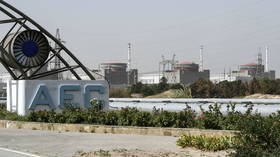Ukrainian attack on nuclear plant repelled – Russian official

A Ukrainian attempt to capture Europe's largest nuclear plant has failed, a senior local official reported on Wednesday morning.
Ukrainian commandos used around 30 speed boats overnight to cross the Dnieper River, targeting the city of Energodar, Vladimir Rogov claimed.
“After artillery shelling of the city, they attempted to land, including to capture the Zaporozhye Nuclear Power Plant. The fighting continued for several hours, at least three or three and a half. The assault was fended off,” he said.
Earlier in the day the city administration reported Ukrainian artillery attacks on several key facilities in Energodar, including the city administration building, an access road, and a transformer station crucial for its power supply. The latter was disabled, causing a blackout, the head of the city administration, Aleksandr Volga, said.
Later in the day, the Russian Defense Ministry stated that the number of troops involved in the Ukrainian operation comprised up to two companies and that a total of 37 boats of various types were used. The military claimed that Kiev lost over 90 soldiers and 14 boats in the botched operation, while its remaining forces were dispersed by Russian artillery fire.
Energodar is located in Zaporozhye Region, one of four former Ukrainian regions that voted to become part of Russia last month. Energodar has been under Russian control since March.
The Zaporozhye Nuclear Power Plant, the largest facility of its kind in Europe, is located on the shore of the Dnepr just outside the city. The site was the focus of a diplomatic spat between Russia and Ukraine, with both sides accusing each other of attacking it and risking a nuclear disaster. Kiev also claimed that Russia was stationing heavy weapons at the facility, which Moscow denies. Russia formally included the plant in its civilian atomic energy infrastructure earlier this month.
The provincial capital, the city of Zaporozhye, remains under Ukrainian control and served as the staging ground for the amphibious operation, according to Rogov.













